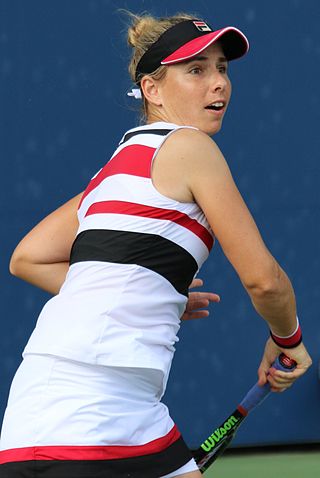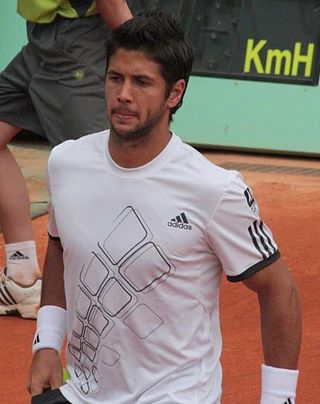
Badminton is a racquet sport played using racquets to hit a shuttlecock across a net. Although it may be played with larger teams, the most common forms of the game are "singles" and "doubles". Badminton is often played as a casual outdoor activity in a yard or on a beach; formal games are played on a rectangular indoor court. Points are scored by striking the shuttlecock with the racquet and landing it within the opposing side's half of the court.

Tennis is a racket sport that is played either individually against a single opponent (singles) or between two teams of two players each (doubles). Each player uses a tennis racket that is strung with cord to strike a hollow rubber ball covered with felt over or around a net and into the opponent's court. The object of the game is to manoeuvre the ball in such a way that the opponent is not able to play a valid return. The player who is unable to return the ball validly will not gain a point, while the opposite player will.
A draw or tie occurs in a competitive sport when the results are identical or inconclusive. Ties or draws are possible in some, but not all, sports and games. Such an outcome, sometimes referred to as deadlock, can also occur in other areas of life such as politics, business, and wherever there are different factions regarding an issue. In some sports, such as cricket, a tie and a draw have different meanings.
In a sport or game, sudden death is a form of competition where play ends as soon as one competitor is ahead of the others, with that competitor becoming the winner. Sudden death is typically used as a tiebreaker when a contest is tied at the end of regulation (normal) playing time or the completion of the normal playing task.

The tennis scoring system is a standard widespread method for scoring tennis matches, including pick-up games. Some tennis matches are played as part of a tournament, which may have various categories, such as singles and doubles. The great majority are organised as a single-elimination tournament, with competitors being eliminated after a single loss, and the overall winner being the last competitor without a loss. Optimally, such tournaments have a number of competitors equal to a power of two in order to fully fill out a single elimination bracket. In many professional and top-level amateur events, the brackets are seeded according to a recognised ranking system, in order to keep the best players in the field from facing each other until as late in the tournament as possible; additionally, if byes are necessary because of a less-than-full bracket, those byes in the first round are usually given to the highest-seeded competitors.
A point in tennis is the smallest subdivision of the match. A point can consist of a double fault by the server, in which case the point is automatically won by the receiver. In all other cases, a point begins when a legal serve is hit by the server to the receiver on the opposite side of the court, and continues until one side fails to legally return the ball to the opposite side. Whichever side fails to do so loses the point and their opponent wins it.
This page is a glossary of tennis terminology.
In games and sports, a tiebreaker or tiebreak is used to determine a winner from among players or teams that are tied at the end of a contest, or a set of contests.
Traditionally, tennis is played between two people in a singles match, or two pairs in a doubles match. Tennis can also be played on different courts, including grass courts, clay courts, hard courts, and artificial grass courts.

Marina Erakovic is a retired tennis player from New Zealand. She achieved career-high rankings of 39 in singles and 25 in doubles, and won one singles title, at Memphis in February 2013, and eight doubles titles on the WTA Tour.

Variations of golf include methods of scoring, starting procedures, playing formats, golf games, and activities based on or similar to the sport of golf which involve golf-like skills or goals.
The 1990 Hopman Cup was the second edition of the Hopman Cup, an international mixed teams tournament played at the Burswood Entertainment Complex in Perth, Western Australia. The event was held from 26 December 1989 through 1 January 1990.
The following outline is provided as an overview of and topical guide to tennis. Tennis is a sport usually played between two players (singles) or between two teams of two players each (doubles). Each player uses a specialized racquet that is strung to strike a hollow rubber ball covered with felt over a net into the opponent's court.

The Isner–Mahut match at the 2010 Wimbledon Championships is the longest tennis match in history. It was a first-round Men's singles match, in which the American 23rd seed John Isner played against French qualifier Nicolas Mahut. The match began at 6:13 pm on Tuesday, 22 June 2010, on Court 18 at Wimbledon. At 9:07 pm, due to the fading daylight, play was suspended before the start of the fifth set. After resuming on Wednesday, 23 June, at 2:05 pm, the record for longest match was broken at 5:45 pm. Play continued until the final set was tied at 59 games all, at which point the daylight faded again, and so play was suspended once more at 9:09 pm. Play resumed again at 3:40 pm on Thursday, 24 June, and eventually Isner won the match at 4:47 pm, the final set having lasted for 8 hours, 11 minutes.

The 2011 Novak Djokovic tennis season is widely regarded as one of the greatest seasons ever in men's tennis. He ended the year with an impressive 10–1 record against Rafael Nadal and Roger Federer, the other two best players of the year. From the start of the year, he went undefeated until the French Open semifinals in June, compiling a 41-match winning streak. Djokovic won ten tournaments, three of them Grand Slam events: the Australian Open, Wimbledon Championships and the US Open. He won a then record five Masters Series 1000 titles: Indian Wells, Miami and Canada, played on hard courts, and Madrid and Rome, on clay. Djokovic also won in Dubai and at the Serbia Open.

The Hopman Cup XXV corresponds to the 25th edition of the Hopman Cup tournament between nations in men's and women's tennis. The tournament commenced on 29 December 2012 at the Perth Arena in Perth, Western Australia.
The Hopman Cup XXVI corresponded to the 26th edition of the Hopman Cup tournament between nations in men's and women's tennis. The tournament commenced on 28 December 2013 at the Perth Arena in Perth, Western Australia.

The 2015 Serena Williams tennis season officially began on 19 January with the start of the 2015 Australian Open and ended with the 2015 US Open. Williams entered the season as the number one ranked player and the defending champion at seven tournaments, including the US Open and the WTA Finals.
Tie Break Tens is a tennis format in which only tie-break matches are played. There are no games or sets, only tie-break matches and the winner is the first player to reach 10 points and lead by a margin of two. Most other traditional rules of tennis are the same. The winner-take-all prize money is US$250,000 for each tournament. It is a short-format version of tennis, similar to other alternative forms of traditional sports, such as T20 Cricket and rugby sevens.
The 2019 Wimbledon Championships Men's Singles final was the championship tennis match of the men's singles tournament at the 2019 Wimbledon Championships. After 4 hours and 57 minutes, first seed Novak Djokovic defeated second seed Roger Federer in five sets to win the title in a repeat of the 2014 and the 2015 Wimbledon finals. It was the longest Wimbledon final in history, and the last major final of Federer's career.








